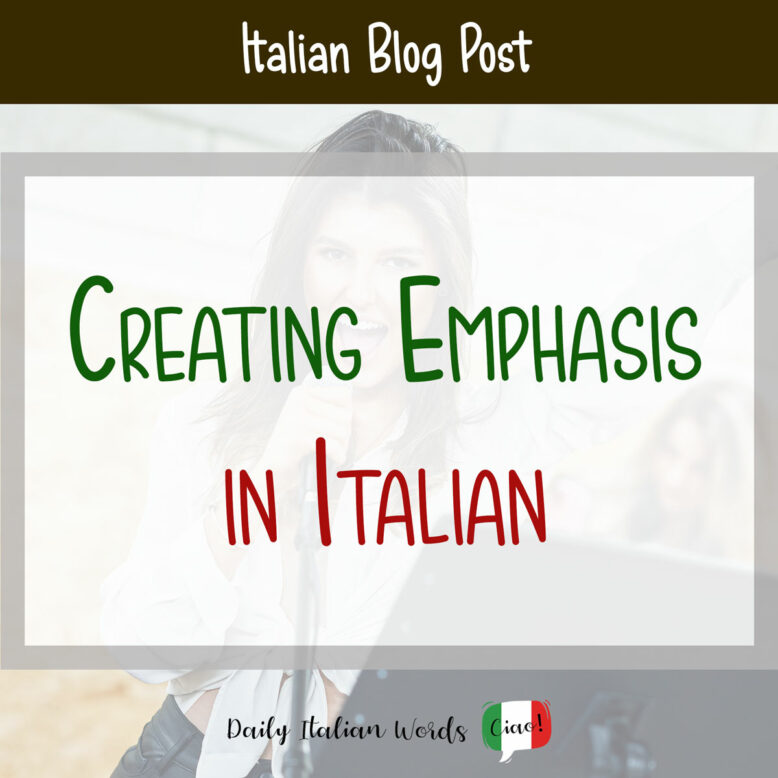Emphasis is defined as “special importance, value, or prominence given to something.” In rhetoric, it refers to the techniques—both intentional and unintentional—that highlight certain elements of a sentence, making them stand out to the reader or listener. The goal of rhetorical emphasis is to enhance communication, whether by conveying urgency, danger, or surprise.
In spoken language, we have more tools at our disposal to make a message more dramatic or persuasive than in writing. A simple hand gesture, a raised eyebrow, or a shift in tone can instantly draw attention to a specific idea without altering the structure of a sentence. However, these prosodic¹ and proxemic² elements are not always easy to represent in written language using punctuation or typography alone. In narrative writing, for instance, these subtle cues often require explicit description.
Both English and Italian rely on similar syntactic strategies to create emphasis in writing. However, Italian—like many Romance languages—offers greater flexibility in word order, making it easier to achieve this effect.
In this article, we’ll explore six key techniques for creating emphasis in Italian. Let’s dive in!
¹ In linguistics, prosody is the study of the phenomena of intonation, intensity, and duration that characterize speech.
² In semiology, proxemics is the study of the meaning that distances between bodies and the use of space can have in human communication.

1. Doubling
When expressing exhortation or disbelief, simply doubling an element within the sentence is often an effective way to emphasise it significantly.
Doubling the verb:
Vai vai, non ti preoccupare, finisco io di mettere a posto
Literally: Go go, don’t worry, I’ll finish tidying up
Guarda guarda chi sta arrivando!
Look, look who’s coming!
Doubling the adverb:
Bevi piano piano che è fredda
Drink slowly slowly, it’s cold
Piove forte forte
Literally: It’s raining heavily heavily
Doubling the adjective:
Sono stato tutto il pomeriggio a casa tranquillo tranquillo
Literally: I spent the whole afternoon at home, quiet quiet
I spent the whole afternoon at home, completely relaxed
Doubling the subject pronoun:
Io, io non lo capisco questo ragionamento
I, I don’t understand this reasoning
Tu, tu sei stato?
You, you did it?
In this context, it is also common to use proprio (meaning really) for added emphasis:
Tu, proprio tu?
You, really you?
We will see other words commonly used to add emphasis in point 6.
2. Repetition
We can add emphasis by incorporating different elements that reinforce the same meaning. Rather than repeating the exact same word, as seen earlier, this technique strengthens the message through redundancy.
For example, in Italian, subject pronouns (io/I, tu/you, lui/he, etc.) are usually omitted before conjugated verbs because the verb ending already indicates the subject. However, when a subject pronoun is explicitly included, it creates a form of repetition—both the pronoun and the verb ending convey the same information. This redundancy naturally emphasises the sentence.
This phenomenon isn’t limited to subject pronouns. Many other pronominal and adverbial particles can introduce a similar effect, reinforcing meaning through repetition and thus adding emphasis.
Let’s look at some examples.
Example 1
Neutral:
Ora guardo la TV
Now I’m watching TV
The subject (I) is implied in the verb ending, the last letter of the word guardo, so there’s no need to explicitly say io.
With emphasis:
Ora io guardo la TV
This might sound as Now I, I’m watching TV.
The use of io (I) here adds emphasis to the subject. It could be used to mark a difference between the speaker and the others (e.g., “Others might be doing different things, but I am watching TV”). The pronoun io helps to highlight that it is specifically the speaker who is doing the action.
Example 2*
Neutral:
Sono stato a Firenze
This translates to I have been to Florence or I was in Florence. It is a neutral statement, where you’re simply stating that at some point in the past, you went to Florence.
With emphasis:
Ci sono stato, a Firenze
This can be translated as I have been there in Florence or I was there in Florence as ci takes the meaning of there.
This repetition (name of the city + there) adds a sense of emphasis or focus on the place itself, indicating that the speaker is specifically referring to the location, or that there may be a context in which the place has already been mentioned.
Example 3*
Neutral:
Vogliamo parlare di questo argomento?
It’s a straightforward question – Do we want to talk about this topic?
With emphasis:
Ne vogliamo parlare di questo argomento?
Although in English the translation remains the same, the addition of ne (which means “about it”) introduces a repetition of argomento (topic). This could indicate that the topic has already been mentioned or is implicitly understood within the context.
* NOTE: Examples 2 and 3 are presented in this article as cases of emphasis through repetition. However, if you were to consult a traditional Italian grammar book, you would find them categorised under dislocazione a destra (right dislocation) or isolamento (isolation). This is because their structure inherently involves repositioning, a phenomenon we will explore in the next paragraph. For clarity—especially for an audience less familiar with Italian grammar terminology—I have chosen to focus on the repetition of elements that convey the same meaning.
3. Repositioning
Italian and English are both classified as SVO languages in linguistics, meaning they typically follow a Subject-Verb-Object word order.
However, Italian frequently deviates from this standard structure to introduce nuances of meaning and, more broadly, to create emphasis. We have already seen this mechanism in examples 2 and 3 from the previous paragraph, where a pronominal or adverbial particle was placed before the verb. That particular structure is known as right dislocation, while the ones we will explore next fall under left dislocation.
That said, delving into technical terminology isn’t strictly necessary to understand the core principle: altering the usual (and neutral) word order shifts the prominence of certain elements, influencing how they are perceived within the sentence.
Now, let’s return to our example about Florence.
Example 1
Neutral:
Sono stato a Firenze molte volte
I have been to Florence many times
With Emphasis by repositioning:
A Firenze ci sono stato molte volte
The standard and neutral word order of the sentence has been altered by shifting a Firenze to the beginning of the sentence, that is, to the left.
Note also the presence of ci, that is both a repetition (there) and an element that makes the melody of the message somewhat more natural. We could add even more emphasis by explicitly stating the personal pronoun for sono stato, which is: io / I.
Io, a Firenze, ci sono stato molte volte
Example 2
Neutral:
Dopo parlo con Marco
I’ll talk to Marco later
With emphasis by (mainly) repositioning:
Con Marco dopo parlo io
It sounds more or less like: I’ll be the one to talk to Marco later
4. Cleft Sentences
Still for the sake of emphasis, the normal SVO word order can be modified even more drastically by breaking a simple message into two separate clauses joined by che / that.
1 Neutral sentence → 2 Cleft sentences
Mi piace la matematica → È la matematica che mi piace
I like math → It’s math that I like
Viviamo in una città tranquilla → È in una città tranquilla che viviamo
We live in a quiet city → It’s in a quiet city that we live
Ho visto Maria al mercato → È Maria che ho visto al mercato
I saw Maria at the market → It’s Maria whom I saw at the market
Questa canzone mi piace molto → È questa la canzone che mi piace molto
I like this song a lot → This is the song that I like a lot
Dobbiamo partire domani → È domani che dobbiamo partire
We have to leave tomorrow → It’s tomorrow that we have to leave
5. Choosing the Personal Object Pronoun
This is perhaps the most chaotic point. Let’s take it step by step.
In Italian, just like in English, there are two types of personal object pronouns: direct pronouns, which are not preceded by a preposition, and indirect pronouns, which are preceded by one. However, in Italian, each of these types has two forms, depending on whether the pronoun appears before or after the verb.
Direct Object Pronoun
Ti chiamo più tardi = Chiamo te più tardi
I’ll call you later = I’ll call you later (emphasising ‘you’)
Lo chiamo più tardi = Chiamo lui più tardi
I’ll call him later = I’ll call him later (emphasising ‘him’)
La chiamo più tardi = Chiamo lei più tardi
I’ll call her later = I’ll call her later (emphasising ‘her’)
Vi chiamo più tardi = Chiamo voi più tardi
I’ll call you all later = I’ll call you all later (emphasising ‘you all’)
Li chiamo più tardi = Chiamo loro più tardi
I’ll call them later = I’ll call them later (emphasising ‘them’)
Indirect Object Pronoun
Elsa mi ha dato un libro = Elsa ha dato un libro a me
Elsa gave me a book = Elsa gave a book to me
Elsa ti ha dato un libro = Elsa ha dato un libro a te
Elsa gave you a book = Elsa gave a book to you
Elsa gli ha dato un libro = Elsa ha dato un libro a lui
Elsa gave him a book = Elsa gave a book to him
Elsa le ha dato un libro = Elsa ha dato un libro a lei
Elsa gave her a book = Elsa gave a book to her
Elsa ci ha dato un libro = Elsa ha dato un libro a noi
Elsa gave us a book = Elsa gave a book to us
Elsa vi ha dato un libro = Elsa ha dato un libro a voi
Elsa gave you all a book = Elsa gave a book to you all
Elsa gli ha dato un libro = Elsa ha dato un libro a loro
Elsa gave them a book = Elsa gave a book to them
Even though the pairs of examples above are grammatically equivalent, there is a difference in real life as the choice of pronoun placement affects emphasis and style. The versions with the object pronoun before the verb are neutral while those with object pronouns after the verb are more emphatic.
Out of context, in fact, if you say chiamo lui, it may sound that you decided to call him instead of another person. Similarly, if you say Elsa ha dato un libro a me, it seems that implicitly she preferred to give a book to you over another person.
But at this point, everything I explained earlier to add emphasis can also be seen after the choice of the personal pronoun: doubling, repetition, repositioning, and cleft sentences.
I’ll condense them all in a single example:
È a me, proprio a me, che lei ha dato un libro
And finally, below, you’ll find an example where both forms of an object pronoun appear in the same sentence. This kind of repetition might shock elementary school teachers, as they typically discourage such redundancy. Nevertheless, I’m including it here because it does occur in informal speech.
A me lei mi ha dato un libro
Something like: to me she gave me a book
6. Common Words for Emphasis in Italian
This list could go on forever, so I’ve selected a handful of words that are very common, and that I think are important to add to your vocabulary.
1. Proprio – it emphasises something being correct or exactly right
È proprio quello che volevo!
That’s exactly what I wanted!
2. Anche – it is used to mean even or really, often emphasising inclusion or surprise or the opposite.
Anche lui lo sa!
Even him he knows it!
Anche no, scusa
That’s a no, sorry
3. Solo – only or just
È solo una questione di tempo
It’s just a matter of time
4. Sicuramente – certainly or surely
Sicuramente ti piacerà
You will surely like it
5. Sul serio – it means both seriously or for real
Stai parlando sul serio?
Are you talking seriously?
Lo faccio sul serio!
I’m doing it for real!
6. Assolutamente – absolutely
Assolutamente no!
Absolutely not!
7. Decisamente – it means definitely
Decisamente sì!
Definitely yes!
8. Veramente or davvero – they mean really or truly, emphasising authenticity or intensity.
È veramente incredibile!
It’s really incredible!

Niccolò Curini has been teaching Italian since February 2016, primarily at the Language Center of the University of Goettingen in Germany. In this role, he led courses ranging from level A1 to B2. To qualify for this position, he obtained the DITALS certification, enabling him to teach Italian as a Foreign Language to university students. Social media: Instagram – Facebook – Twitter


